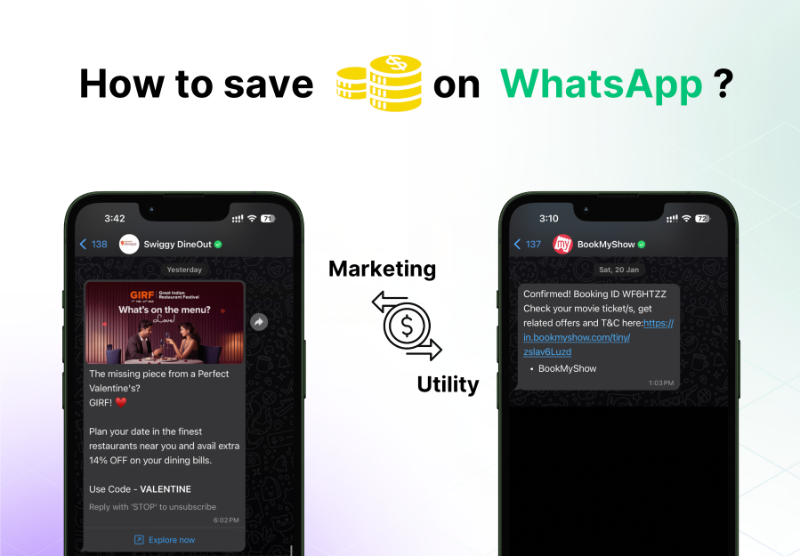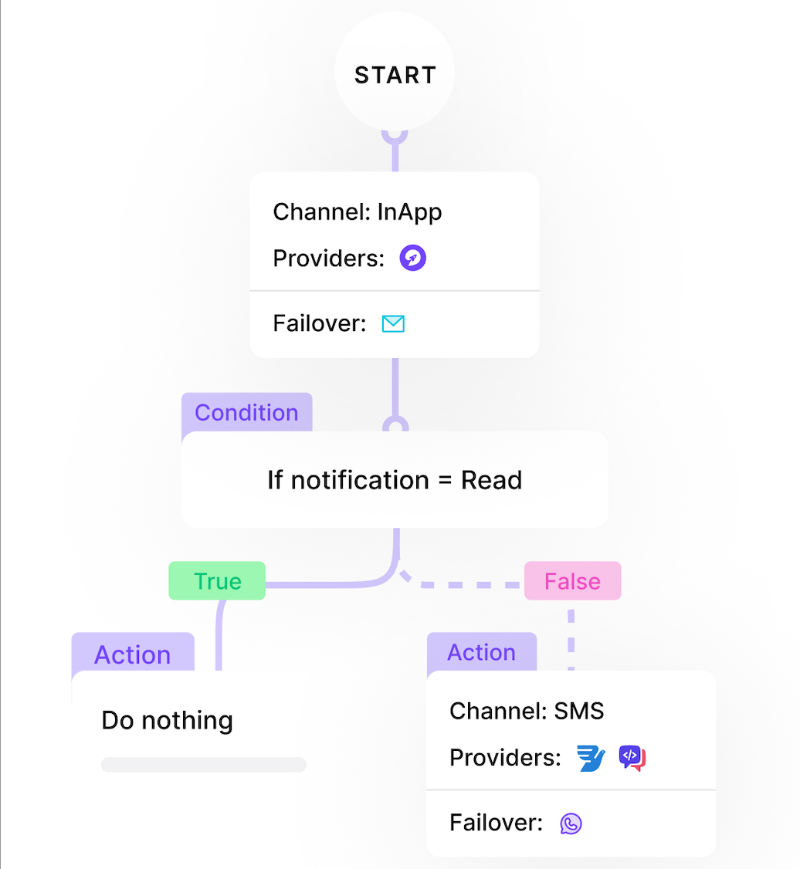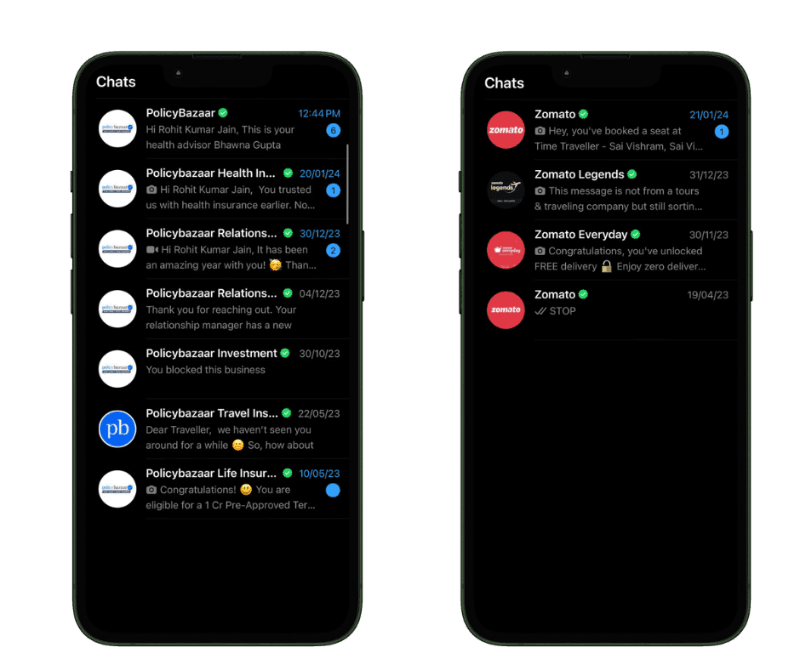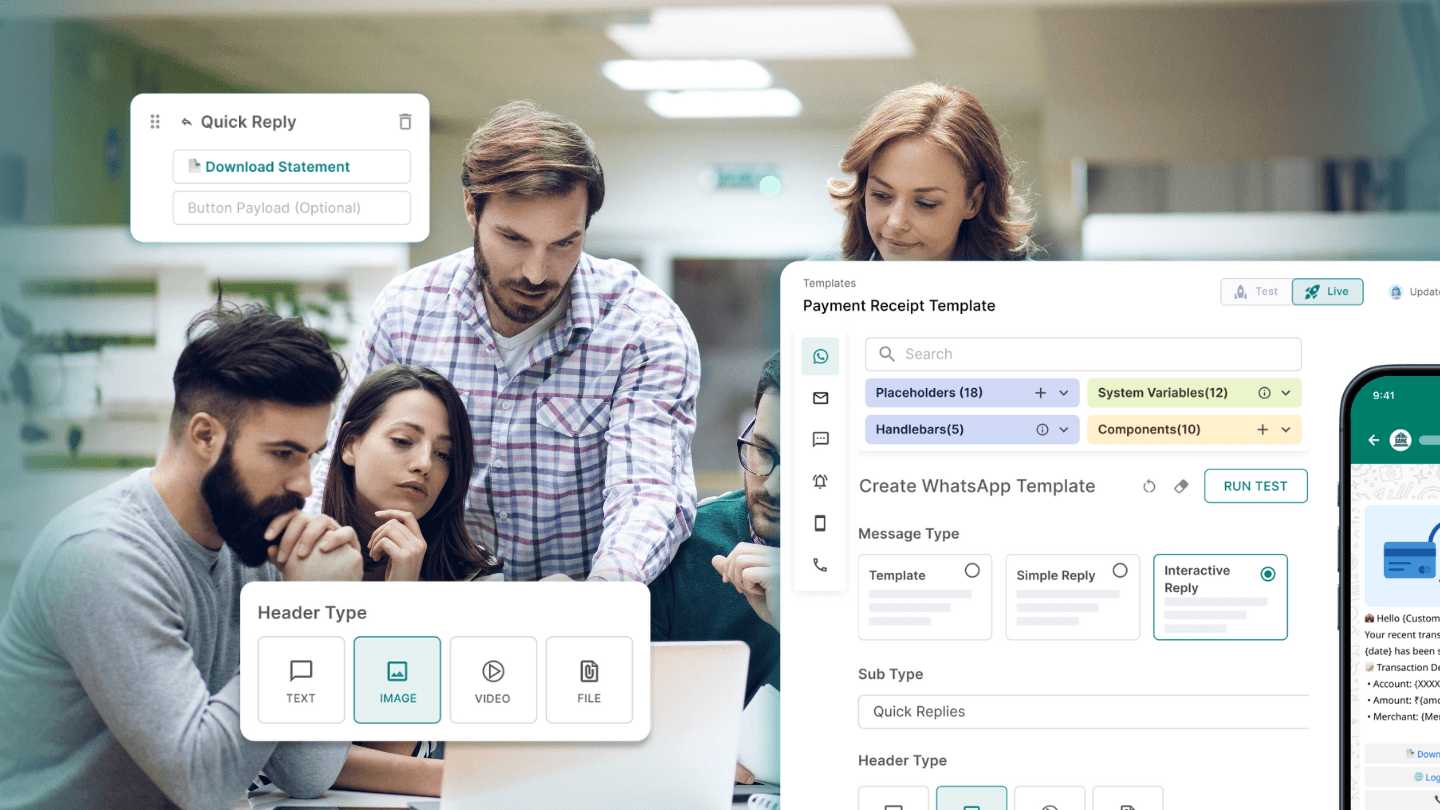In recent years, the digital communication landscape for businesses has seen a significant shift, with many moving away from traditional channels like SMS and email to embrace newer, more interactive platforms like WhatsApp.
This transition is driven by the desire to meet customers where they are most active and to leverage the rich, engaging experiences that platforms like WhatsApp can provide. Digital-first businesses, in particular, have been quick to adopt WhatsApp because of:
Widespread usage
High engagement rates
Ability to send rich media messages, including images, videos, and interactive elements, which are not possible with SMS or email
Evolving technology that is innovating almost every week, providing various opportunities for businesses to grow
WhatsApp’s appeal is further enhanced by its end-to-end encryption, ensuring secure conversations between businesses and their customers. The platform also offers features such as read receipts and the ability to easily start conversations, making it a more interactive and personal way to engage with customers. This has made WhatsApp an attractive option for customer service, marketing, and transactional communications.
However, as businesses increasingly adopt WhatsApp, concerns around cost have become more prominent. Unlike SMS or email, where costs are relatively low and predictable, WhatsApp’s conversation-based pricing model can lead to higher expenses.
There are two main types of conversations: user-initiated conversations, where businesses incur charges only when responding to a customer's message, and business-initiated conversations, which are activated when a business proactively reaches out to customers and often involve higher fees.
Additionally, service conversations, which occur when a customer initiates contact, are the least expensive type of messaging, making them a cost-effective option for customer support.
Before diving into how to save costs, let’s understand the pricing structure more clearly.

WhatsApp Business pricing structure
WhatsApp charges businesses for each 24-hour conversation window initiated with a customer, varying rates depending on the message type and the recipient’s country. You can find more about the 24-hour conversation window here with examples.
The charge is only when messages you send to customers are delivered. The following are the charges in India:
Marketing conversation: ₹ 0.7265/conversation - 0.7846
Utility conversation: ₹ 0.3082/conversation - 0.1
Service conversation: ₹ 0.2906/conversation - 0.2906
If you are using a BSP to access WhatsApp APIs, you will pay 10-25% more. The WhatsApp Business API pricing structure can vary significantly based on the WhatsApp Business Solution Provider chosen, so it's crucial to research different providers to find the best fit for your needs.
Prima-facie is obviously more expensive than traditional channels like Email and SMS, which cost ~ 1 paisa per Email and ~ 15 paise per SMS.
However, there are multiple reasons businesses opt for WhatsApp over SMS despite its higher cost. Check here to dive deep into why businesses opt for WhatsApp over SMS.
Now that we understand the cost structure (which is obviously expensive) let’s identify how businesses can control and reduce WhatsApp costs effectively without affecting customer experience.
6 effective ways to reduce WhatsApp costs
The last few cost-saving recipes are technology and intelligence, which can lead to significant savings. Utilizing free conversations through platforms like WhatsApp can help businesses interact with customers without incurring additional costs, especially when customers initiate contact through free entry points like click-to-WhatsApp ads.
Additionally, free entry point conversations allow businesses to send templates during a three-day window without extra charges, enabling cost-effective marketing and service interactions.
1. Work with a Tech partner instead of a BSP
Business Service Providers who act as resellers of WhatsApp will almost always have an added margin of ~ 10-25% over and above the WhatsApp costs and some fixed platform or service fee.
When you use a Tech Partner, you deal directly with WhatsApp for your commercials and payments and have access to the direct WhatsApp costs. Additionally, if you choose to use your private number, it will be converted into a business account, meaning you cannot have both types of accounts on the same number. This distinction is crucial when considering the WhatsApp Business App, the WhatsApp Business Platform, and other account types, each with its own limitations and requirements.
A Tech Partner like Fyno will provide you with better technological access and all the necessary orchestration/workflow builders to use WhatsApp.
This straightaway can save ~ 10-25% upfront. We have captured the benefits of working with a Tech Partner in detail here.
The most interesting part of working with a Meta tech partner is that it will give you very early access to its new features. Something like WhatsApp flows, for instance.
2. Categorise template messages appropriately
Ensure that you are correctly understanding and selecting the message category for your template. Sometimes, people may save and apply for a transactional/ utility message as a marketing message, which attracts the highest tier of WhatsApp charges (ie, 73 paise) per message rather than ~32 paise.
3. Leverage free entry points
Click to WhatsApp Ad: If you are using Meta for Facebook and Instagram marketing as well, in some of your campaigns, you can use your Call to Action smartly to land the users in your WhatsApp channel. Such conversations will open a free 72-hour window with the customer.
Now, one may read between the deals to identify that WhatsApp is not offering a great hack or a generous deal. WhatsApp is not charging for this since you are already paying Meta for the successful Ad campaign when someone clicks on the CTA.
Facebook Page—CTA: Now, this is really a freebie using WhatsApp and the Meta ecosystem. You can add a WhatsApp conversation button/ CTA to your Facebook page. Users who initiate a conversation with a business using that button open up a 72-hour free window with the customer.
So, if your organic efforts/ content land your customer on the Facebook page, and such a user clicks on the WhatsApp CTA, a 72-hour free window will open. This is one example of an end-to-end free journey to establish a user touch point.
Please note that for both of the free entry points discussed above, you need to respond within 24 hours to enjoy the 72-hour free window.
The next 4 methods are only achievable using some sophisticated tech stack or infrastructure.
4. Use intelligent multi-channel routing/ workflow
Implementing intelligent multi-channel routing or workflow can significantly reduce communication costs for businesses, especially when considering the use of WhatsApp in conjunction with other channels like email, in-app notifications, and SMS.
By prioritising messages on low-cost channels first and waiting for a brief period (15 minutes to 1 hour) to check if the message gets read before deciding to send a WhatsApp message, businesses can potentially save on the higher costs associated with WhatsApp communications.

This strategy is particularly effective for non-time-sensitive communications, such as marketing messages, where the timing of message delivery is flexible.
Even if 20% of users engage with the message on these alternative platforms, it saves ~20% of WhatsApp's overall costs. Imagine if you are paying a WhatsApp bill of $5000 each month; you can potentially save $1000+ or even more with this strategy.
This approach underscores the importance of a well-thought-out multi-channel communication strategy that optimizes the use of various channels based on cost, engagement rates, and user preferences.
In practice, this means leveraging tools and analytics to monitor where users are most likely to engage with communications and using this data to inform the channel choice. For example, if analytics indicate that a significant portion of the target audience engages with emails or reads in-app notifications, these channels can be prioritized for initial communications.
If the desired engagement level is not reached within a certain timeframe, the communication can then be escalated to WhatsApp or other higher-cost channels.
5. Leverage the 24-hour window intelligently
Many businesses use multiple WhatsApp numbers or accounts to message their customers. There can be multiple reasons - for example:
Different marketing teams independently run campaigns in silos.
A company has multiple segments, each with a different WhatsApp number.
Some users may have blocked one or more of the Company’s numbers, necessitating the Company to have multiple WhatsApp accounts.
Companies using different WhatsApp accounts for marketing, transactional or service messages

Businesses operating multiple WhatsApp numbers can manage session tracking across these accounts. If a conversation with a customer is initiated from one number, Fyno ensures that all subsequent messages within the 24-hour window can be sent from the same number/account so that you don’t get charged additionally on the other account. This is particularly important for business-initiated conversations, where proactive outreach to customers can incur different fees based on the type of conversation and the necessity of using template messages.
Example: A retail brand with separate WhatsApp numbers for customer service and promotional communications initiates a service conversation. Later, they decide to send a follow-up satisfaction survey and a promotional offer within the same 24-hour window.

They can ensure these messages can be sent from the service account, leveraging the open conversation window and avoiding additional session charges that would incur if the other account were used.
For marketing messages, which are a significant component of digital communication strategies, the costs on WhatsApp can be notably higher compared to traditional SMS or email campaigns.
6. Leverage user Intelligence
A great start here is to understand your user base effectively. Often, service / transactional messages can improve engagement, retention, and repeat purchases more than an explicit marketing nudge with offers.

This evaluation is possible only by testing templates, gathering insights on how each template performed in terms of engagement, click rates/ open rates and then storing the intelligence per user to leverage it in future communications.
Once you have these insights, you can ensure that every time a specific engagement and retention campaign is run, the appropriate category of WhatsApp messages is sent to users. Even if 20-30% of your users like service-based retention techniques, it will directly half your promotional WhatsApp costs while delivering a better communication experience.
The platform offers analytics that enables businesses to monitor the performance and cost implications of different types of messages and conversation categories. Fyno's flexibility allows for real-time adjustments to strategies, ensuring that businesses can respond to data-driven insights by modifying their communication workflows to optimize for engagement and cost efficiency.
By leveraging Fyno's modular communication infrastructure, businesses can ensure that their engineering and product teams are not barriers to optimizing WhatsApp usage and minimizing costs.
Instead, they're empowered to implement logical workflows and change rules on the fly, taking full advantage of cost rationalization tips without being constrained by their codebase or initial platform design decisions. This approach helps not only control costs but also maintain agility and responsiveness in customer communication strategies.
To sum it up
Businesses must effectively navigate this cost-benefit landscape. Understanding how much WhatsApp Business costs is crucial for effective cost management. Strategies such as optimizing the use of the free conversation quota, leveraging other channels in conjunction with WhatsApp, and employing targeted communication tactics to reduce unnecessary messaging costs are becoming increasingly important.
Navigating the costs associated with WhatsApp for business communications requires a nuanced understanding of the platform’s pricing model and an intelligent approach to message orchestration. A robust technology stack becomes critical here, enabling businesses to employ sophisticated strategies for minimizing costs without compromising on customer experience.
Today's reality and why you need Fyno
Unfortunately, many companies operate with limited technological capabilities, relying on basic communication services or marketing automation tools that lack the depth needed for effective cost management on platforms like WhatsApp.
The WhatsApp Business Premium and WhatsApp Business Premium App offer enhanced features tailored for business use, providing a more organized way to manage customer interactions. However, they currently offer limited functionality and have some data protection concerns, making them less suitable for larger businesses.
Such limitations often mean missing valuable opportunities to optimize messaging strategies and reduce expenses. In this context, a technology solution like Fyno becomes invaluable.
Fyno’s advanced communication infrastructure and automated routing capabilities empower businesses to implement intelligent cost-saving measures seamlessly.
Fyno’s status as Meta’s official tech partner underscores its proficiency in delivering WhatsApp-focused enhancements, highlighting its capability to navigate the platform’s complexities and unlock cost efficiencies.
1. Advanced communication infrastructure
Fyno’s modular communication platform integrates various communication channels into a unified system. This omnichannel customer communication approach enables businesses to manage all their notifications from a single interface, reducing the complexity and cost of using multiple platforms.
This ensures you can configure message routes to deliver through the most cost-effective channels, thereby reducing your communication costs just like Blitz did.
Moreover, sophisticated routing and failover protocols enhance the reliability and efficiency of communications, contributing to further cost reductions.
2. Integration with existing systems
Fyno offers seamless integration with existing business systems, ensuring a smooth transition without disrupting ongoing operations - with a unified API. This integration capability allows businesses to enhance their communication strategies without significant upfront investments.
Conclusion
Reducing WhatsApp costs is crucial for businesses aiming to optimise their communication expenses. Implementing efficient multi-channel communication strategies, like those we offer, can significantly cut costs by over 30%. A robust technology stack is essential for managing these costs effectively, ensuring seamless operations, and automating complex workflows without taking any of your engineering bandwidth — that's our promise!
Explore Fyno.io’s solutions to optimize WhatsApp communication costs, streamline processes, and achieve significant savings. Visit Fyno.io to learn more and request a demo today.
FAQs
1. How can working with a tech partner help reduce WhatsApp costs?
Working with a tech partner can save you approximately 10-25% upfront by avoiding the added margins and fixed fees associated with Business Service Providers (BSPs).
2. What is the importance of categorising template messages correctly on WhatsApp?
Categorizing template messages correctly ensures you are not overpaying for message types. For example, categorising a transactional message as a marketing message can cost significantly more.
3. How can leveraging free entry points like Click to WhatsApp Ads help save costs?
Using free entry points such as Click to WhatsApp Ads or a WhatsApp CTA on your Facebook page can open a 72-hour free window with the customer, saving on conversation charges during this period.
4. What is intelligent multi-channel routing, and how does it help reduce costs?
Through intelligent multi-channel routing, you can start by sending a message through one channel and set a goal, such as ensuring it is delivered or read. Depending on whether the goal is met, you can then trigger the communication through another channel. This approach prevents spamming customers with the same message across multiple channels, thereby saving communication costs.
5. How can businesses leverage the 24-hour conversation window effectively?
Businesses can manage session tracking across multiple WhatsApp accounts to ensure that all messages within the 24-hour window are sent from the same account, avoiding additional charges for new sessions.


